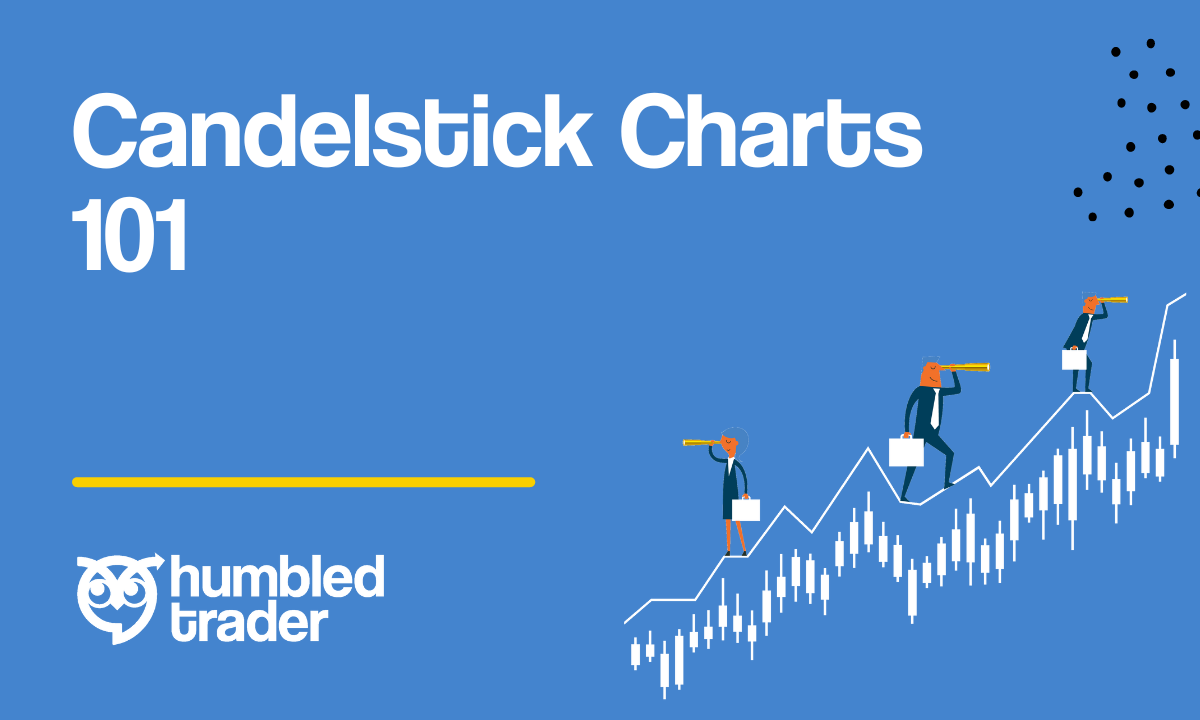Candlestick Charts 101

If you are one of those who get confused when reading candlestick charts, then this is for you. Perhaps, you belong to the category of those who would try a new means of reading charts; if so, also welcome aboard. Today, I will be answering your age-old questions about candlestick patterns.
Over the years, candlestick patterns have become extremely popular with a lot of traders, with some even swearing by how easy it is to read and predict stock market patterns with candlestick charts in lieu of popular charts like Bars and Reiki.
You know what? They are mostly right, as the candlesticks are easier to read and follow as opposed to bar charts and other types of charts. I know that for most beginners or newbies, these charts look like a bunch of jargon. Well, you are not alone in this. Yeah, I once thought it was garbage until I understood how fun and exciting it is.
So, for you to understand candlesticks, we need to start with the basics.
What are candlestick charts?
Candlestick charts, like other charts, are tools for displaying the demand and supply of a particular stock. In simple terms, it involves the use of candle-like diagrams to dictate the bullish or bearish trend for each time frame for day trading, swing trading and longer term investing.
Before we can talk about these candlestick patterns, let’s go over an individual candlestick. Each candlestick represents a specific time frame. Therefore, a 1-minute candlestick will represent one minute of trade data; the same goes for 5 min and the daily.
Each candlestick is divided into 3 parts: the upper shadow, the lower shadow, and the body. On a candlestick, there are four data points you need to know when studying candlesticks - the high, the close, the open, and the low.
The Body of the Candle
Let’s ignore the wicks at the top and bottom of the candle for now and look at the body.
The open is the starting point for a specific period of trade that the candle represents, while the low is the end of the specific period of trade. Sometimes, some trading platforms use black and hollow candles to represent bearish and bullish trends. As a trader who wants to use candlestick charts, you should know that a candlestick is bearish if the close position is lower than where it opened. A candlestick is bullish if the close position is higher than when it opened.
The Wick of the Candle
Now, let’s look at the vertical line or wick running through the body of the candle.
The upper part of the wick, which is also called the High, represents the highest price, while the wick on the lower end of the candle is called the low. It represents the lowest price for that time frame.
Generally speaking, when you see wicks at the top, that means the stock is sold into on the breakouts, which is technically bearish. This could be on 1 min, 5 min, or daily charts. The bottom wick is, of course, the opposite. This means the dips or the sell offs are being bought up and are often bullish within the specified time frame.
However, knowing the anatomy of a candlestick and bullish or bearish look is just half the story. It’s more important to put these candles together when trading and look at these candlestick trends as a formation or a pattern.
Now, you guys know I don't really believe in memorizing patterns rather than looking at the price action, but it’s still important.
Candlestick Patterns
In candlestick charts, there are over 16 patterns. Scary, right? I understand how overwhelming it can be for newbies and beginners. It is for this reason that I’m only going to cover 5 candlestick patterns: doji, bearish/bullish engulfing, morning/evening star, one white soldier/black crow, and bearish/bullish pin bars. These patterns are the major ones you need to watch out for when reading a candlestick chart.
Doji pattern
Before we start with the other patterns, let’s talk about the doji. The doji is a pretty common candlestick chart we see daily, when the closing and the opening position are the same. The body of the candlestick looks like a dash.
When you come across the doji, it means both the buyers and sellers are indecisive and you will often find doji’s candles during periods of rest after a major bullish or bearish trend.
Nevertheless, a doji pattern means that the previous trend is losing strength. Therefore, buyers are often advised to take some of their profits at this point before the next uphill or downhill market trend.
Bullish/bearish engulfing patterns
This is the first major candlestick pattern you need to watch out for. A bullish engulfing candlestick pattern occurs when a large green candle completely breaks above the previous red candle.
That's why it's called engulfing. It's like the shark from “Jaws” just eating up the previous candle, or also me at the table when I go out to eat.
When you come across a bullish engulfing candle, it means that the buyers have taken complete control of the stock and are bidding the prices higher. Hence, there’s a buying frenzy. Bullish engulfing patterns show that there’s a potential reversal on downward trends, especially if the stock is very beaten down intraday day or on the daily.
On the other hand, bearish engulfing is the opposite and is often a sign of a bearish sentiment. When a large red candle completely engulfs the preceding green candle, a strong bearish will engulf not only the green candle body but also the wicks.
When you come across this pattern, it means there's a massive selling activity that leads to a panic reversal of prices. A lot of times, we’ll see these on small cap penny stocks.
Here’s a tip I always advise new traders to try out when reading candlestick patterns; practice how to identify and trade using these patterns on a demo account. This will minimize your risk profile.
So, do you feel like a pro already? Just wait till we discuss the next two candlestick patterns for you to try out.
Morning/evening star patterns
The morning or evening star candlestick patterns show a shift in control either from buyers to sellers or from sellers to buyers. The morning star, for instance, is a bullish candlestick pattern that forms after a decline in prices.
Three candle bars form a morning star pattern; the first candle has a bearish end, which shows that the sellers are in control. The second candle occupying the middle position has a very small body or range and is often a doji. As we discussed earlier, dojis show that the sellers and buyers are indecisive. The third candle closes aggressively and is about 50% higher than the first candle (bearish). When you see a morning star, it means that the buyers won against the sellers and are momentarily in control.
On the other hand, evening stars are a bearish candlestick reversal pattern that forms after an increase in price. Like the morning star, this pattern is also formed from 3 candle bars. Unlike the morning star, evening stars are formed by a bullish candle (the first), a doji (which occupies the middle), and a bearish candle (the third). The bearish candle, which is also the third, has a closing position more than 50% lower than the bullish candle. An evening star tells you that the buyers are exhausted, and the sellers are temporarily in control.
One white soldier or black crow pattern.
The one white soldier is a bullish candlestick that is used to effectively predict the reversal of a downtrend in a price chart.
So, how can you identify a one white soldier pattern?
You have a One white soldier pattern when the bullish candlestick opens above the previous day’s close and closes above its open.
So, how can you accurately know if it's a One white soldier? First, it must have a prevailing downtrend. Second, the length of the second-day candlestick must open above the preceding day’s close, and it must close above its open. Mind you, the length of the candlesticks should not be short.
The Black Crow, on the other hand, is a bearish candle reversal pattern. Just like the One white soldier, the Black Crow pattern consists of two candles. In a Black Crow, the first candle is bullish due to a positive market sentiment, while the second candle is bearish as market sentiments turn sour. Once again, how can you know a one black crow pattern? The first indicator is when the first candle is bullish and part of an upward trend. The second is when the second candle is bearish and opens lower than the previous day’s high, and closes lower than the open. When you come across one black crow, it means there’s a shift towards the bearish trend, which leads more to selling than buying.
At this point, you are probably thinking, “how am I going to remember all these patterns?” Well, here are a few tricks to help you read candlesticks like a pro.
Pattern Memory Tricks
First, understand who controls the trend. Is it the buyers or the sellers? You know this by studying the candle wick’s length. A longer wick denotes a weak position, while a short wick represents a strong position. Therefore, a bullish candle with a long wick means that the buyer position is weak, while a short wick on a bullish candle shows that the buyer position is strong.
Next, ask the question, “What’s the size of the pattern when compared to the other candlestick patterns?” This will let you know if there’s a strong conviction behind the move. What you want to do is compare the size of the current candle to the earlier candles. There’s a strong conviction if the current candle pattern being studied is at least two times larger than the preceding candles.
The upper and lower shadows are referred to as wicks, and they may vary in length. These wicks are important information for trading price action, which we’ll go over later on.
Sometimes, some trading platforms use black and hollow candles to represent bearish and bullish trends. As a trader who wants to use candlestick charts, you should know that a candlestick is bearish if the close position is lower than where it opened, and a candlestick is bullish if the close position is higher than when it opened.
For instance, Let’s say a 5-minute TSLA opening position is $1,800.00. It is bullish if the close position is higher than $1,800, and it is bearish when the close position is lower than the open position. It’s no surprise that for over 300 years, candlestick patterns have helped traders to judge market sentiments and to know whether it is the buyer or seller that’s controlling the price range.
Bullish/Bearish Pin Bar Pattern
The next pattern on our list of the major patterns is the pin bar pattern. Before we go into the types of pin bar patterns, we need to understand what pin bars are. Pin bars in candlestick charts are candles with a long upper or lower wick. More so, pin bars generally have short bodies when compared to their wicks. The long wick is usually two or three times longer than the body, and it shows the areas of the price that were rejected.
Therefore, a bullish pin bar, which is usually formed in an up-trending market, has a longer and lower wick, which represents the rejection of lower prices. On the other hand, a bearish pin bar has a longer upper tail that shows the rejection of higher prices.
Pin bars, either bullish or bearish, basically show a reversal in the market. They are very good for knowing the short-term direction of price. Pin bars often mark major downhill or uphill turning points in a market. Be mindful that not every pin bar is worth trading.
Over the years, I have discovered that the best pin bars to trade occur in strong trends, preferably after a retrace to resistance within the trend. Moreover, beginner traders should always watch out for at least a 4-hour chart pin bar. By doing this, you will get an accurate prediction of the direction of the pin bar.



